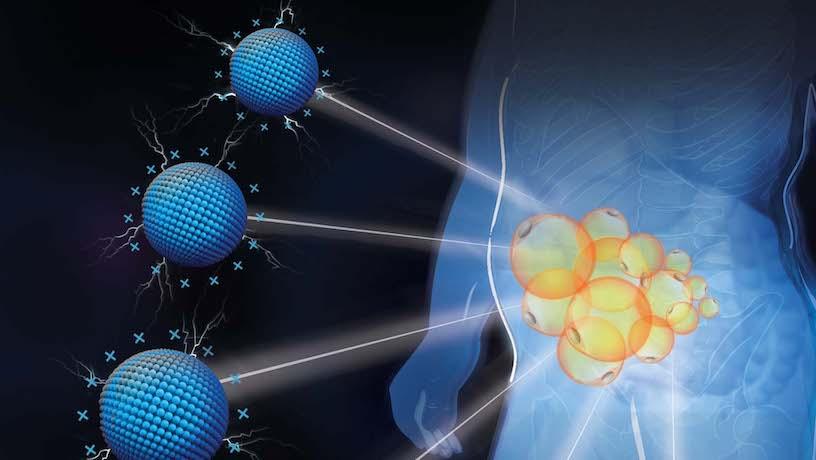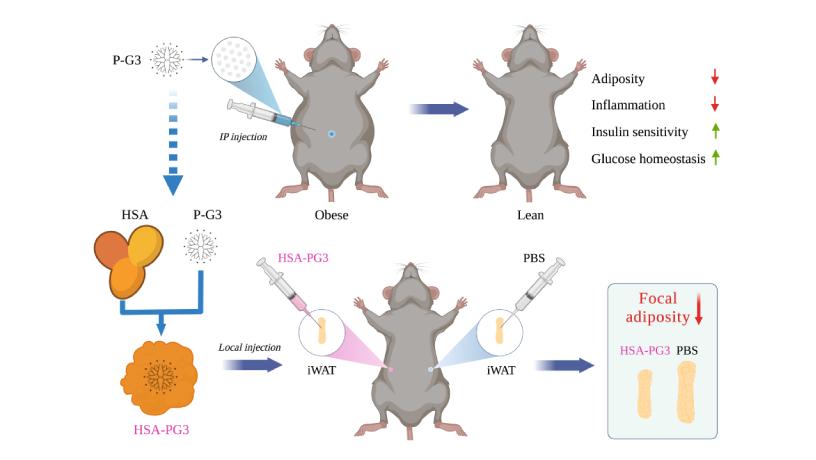Columbia researchers discover that the cationic charged P-G3 reduces fat at targeted locations by inhibiting the unhealthy lipid storage of enlarged fat cells

Challenges in targeting fat cells
Nanomaterials Treat Obesity Anywhere You Want: The ability to target fat cells and safely uncouple unhealthy fat formation from healthy fat metabolism would be the answer to many peoples’ prayers. A major challenge in obesity treatment is that fat tissue, which is not continuous in the body but is found piece by piece in “depots,” has been difficult to target in a depot-specific manner, pinpointed at the exact location.
There are two main kinds of fat: visceral fat, internal tissues that surround the stomach, liver, and intestines, and subcutaneous fat, found under the skin anywhere in the body. Visceral fat produces potbellies; subcutaneous fat can create chin jowls, arm fat, etc. To date, there has been no way to specifically treat visceral adipose tissue. And current treatments for subcutaneous fat like liposuction are invasive and destructive.
New studies use cationic nanonmaterials to target fat
Nanomaterials Treat Obesity Anywhere You Want: Two new studies from researchers at Columbia Engineering and Columbia University Irving Medical Center (CUIMC) may have the answer to targeting fat cells depot-specifically and healthily. The papers demonstrate a new method to treat obesity by using cationic nanomaterials that can target specific areas of fat and inhibit the unhealthy storage of enlarged fat cells. The materials remodel fat rather than destroying it, as, for example, liposuction does.
The first paper, published today by Nature Nanotechnology, focuses on visceral adiposity, or belly fat. The second paper, published online November 28 by Biomaterials, focuses on fat underneath the skin as well as chronic inflammation associated with obesity.
The team of researchers, led by Li Qiang, associate professor of pathology and cell biology at CUIMC, and Kam Leong, Samuel Y. Sheng Professor of Biomedical Engineering and of systems biology at CUIMC, recognized that adipose tissue contains large amounts of negatively charged extracellular matrix (ECM) to hold fat cells. They thought that this negatively charged ECM network might provide a highway system of sorts for positively charged molecules. So they took a positively charged nanomaterial, PAMAM generation 3 (P-G3), and injected it into obese mice. The P-G3 quickly spread throughout the tissue and the team was excited that their method to specifically target visceral fat worked.
Unexpected results
P-G3 helps new fat cell formation and also inhibits the unhealthy lipid storage of enlarged fat cells
With P-G3, fat cells can still be fat cells, but they can’t grow up. Our studies highlight an unexpected strategy to treat visceral adiposity and suggest a new direction of exploring cationic nanomaterials for treating metabolic diseases.
New applications for drug delivery, gene therapy, and aesthetics
Nanomaterials Treat Obesity Anywhere You Want: Nanomaterials Treat Obesity Anywhere You Want: Now that they can selectively target visceral fat, Leong and Qiang envision several applications. The Biomaterials study demonstrates a simple approach that could be used for aesthetic purposes; like Botox, P-G3 can be locally injected into a specific, subcutaneous fat depot. The investigators, who have patents pending, are now engineering P-G3 into various derivatives to improve the efficacy, safety, and depot specificity.
What the researchers are particularly excited about is developing P-G3 into a platform that can deliver drugs and gene therapies specifically to a given fat depot. This may repurpose many drugs from systemic safety concerns, such as Thiazolidinediones (TZDs), a potent but unsafe drug that is a strong modulator of fat and used to treat type 2 diabetes—but it has been linked to heart failure and banned in several countries.
“We’re very excited to discover that cationic charge is the secret to targeting adipose tissue,” Qiang said. “Now we can shrink fat in a depot-specific manner–anywhere we want–and in a safe way without destroying fat cells. This is a major advance in treating obesity.”
Nanomaterials Treat Obesity Anywhere You Want: Original Article










